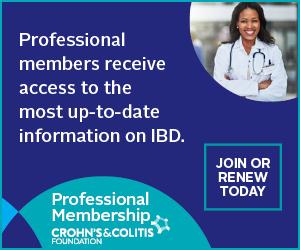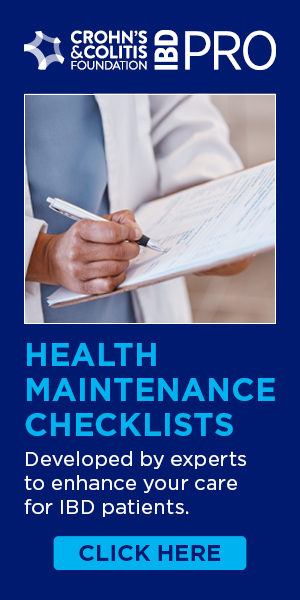Clinical Pearls
The Foundation's Clinical Pearls is an educational series consisting of brief "hot-topic" summaries of practical and clinically relevant information coupled with visual abstracts. They are developed using the best available evidence and experts' clinical knowledge and experience.
Clinical Pearls is produced by members of the Professional Education Committee, a subset of the National Scientific Advisory Board. See our featured Clinical Pearl below, or browse past works.
Over 70% of newly diagnosed ulcerative colitis (UC) cases in adults present with disease activity limited to the left side of the colon, distal to the splenic flexure.1-3 Left-sided UC (L-UC) includes ulcerative proctitis (UP) (involvement of rectum only), proctosigmoiditis (involvement of rectum and sigmoid colon), and left-sided colitis (disease extending into descending colon or splenic flexure).4
Recognition of L-UC is clinically important because rectally administered topical therapy works more rapidly and effectively in distal disease than oral agents.5,6 Additionally, early appropriate treatment of L-UC may delay or prevent proximal extension,7 which is seen in up to 20-30% of patients within five to ten years.8-10
Treatment of Mild-to-Moderate Left-Sided UC and UP
The aims of medical management of patients with L-UC, as with all cases of inflammatory bowel diseases, are to induce remission in active disease and to minimize the risk of relapse. In treating active L-UC, efficacy and targeting of the drug to the distal colon are key priorities.6,11
Rectally administered topical therapy is the preferred treatment of active mild to moderate L-UC.12 Suppositories reach the upper rectum, approximately 15-20 cm above the anal verge, which is ideal for UP, while enemas can extend to splenic flexure, which is needed for L-UC. In both mildly active UP and L-UC, initial treatment recommendations include rectal 5-aminosalicylate (5-ASA) topical therapies at a dose of at least 1g/day for induction of remission.2,12 For L-UC, addition of oral 5-ASA to the aforementioned rectal topical therapy is also recommended at a dose of at least 2g/d to induce remission.13,14
Clinical improvement should occur within 2-4 weeks of therapy, and if no response occurs, hydrocortisone enemas can be substituted for 5-ASA. However, if oral and rectal 5-ASA topical therapy and/or rectal corticosteroids are not effective, then oral corticosteroids (budesonide multi-matrix 9mg/day15, prednisone 40mg/day or equivalent) are recommended to induce remission. The 5-ASA therapy (oral and rectal topical) should be continued during the course of corticosteroids to help with maintaining UC remission once prednisone is tapered and discontinued (generally decreasing the steroids by 5-10mg/week after 1-2 weeks of clinical response). 2,6
Treatment of Moderate-to-Severe Left-Sided UC and UP
Patients with severe L-UC can have profound diarrhea, hematochezia, fevers, elevated inflammatory markers including CRP, ESR, fecal calprotectin and white blood cell count, and should be hospitalized for further treatment. Reevaluation using stool studies, abdominal imaging and repeat endoscopy with ileal inspection may be necessary to rule out alternative diagnosis including infection (such as Clostridium difficile and cytomegalovirus), Crohn’s disease, medication effects, and noncompliance. 2,11
If refractory severe L-UC is confirmed, patients may require treatment with intravenous (IV) corticosteroids to induce remission. If clinical response is achieved with IV steroids, transition to oral budesonide or oral prednisone may be appropriate with outpatient taper as described above and transition to appropriate maintenance therapy. In patients who are refractory to 5-ASA and IV corticosteroids, administration of infliximab may be indicated as rescue therapy to avoid colectomy 16,17 and should be continued for maintenance therapy. Cyclosporine or tofacitinib may also be considered in refractory patients with distal UC, however the safety profile of these drugs must be strongly considered prior to initiation6. Patients who remain refractory to all medical therapy may ultimately require a total proctocolectomy with either ileal pouch-anal anastomosis or end ileostomy in order to control and contain inflammation as well as prevent the development of colon cancer in a severely inflamed colon.
Maintenance Therapy for Left-Sided UC and UP
The efficacy of the medication in combination with its long-term safety, tolerability, convenience and acceptability to the patient are important for choosing the appropriate maintenance therapy for patients with left-sided UC. Rectally administered 5-ASA therapy is effective for maintenance of remission in UP and for most patients with L-UC. If oral and rectally administered 5-ASA therapies were necessary to induce remission, then maintenance with combination of agents may be required.2
Patients with UP who respond to at least one month of daily rectal topical therapy may taper to every-other-day dosing to maintain response. However, only a small percentage of patients are able to discontinue therapy completely with over 50% of UP patients relapsing within one year18. L-UC patients who are refractory to oral and rectal 5-ASA topical therapy and are steroid-dependent should be treated with either immunomodulators (e.g.: azathioprine or 6-mercaptopurine) and/or biological or a small molecule agent approved for ulcerative colitis. 2,6 It is important to note that although short term (30 day) response may be achieved with corticosteroids, only half of the patients are corticosteroid free without requiring surgery at 1 year19,20. Thus, the appropriate therapy for patients who are refractory to 5-ASA therapy and require corticosteroids would be to initiate appropriate biologic therapy after induction of remission rather than re-initiation of only 5-ASA therapy after steroid taper is completed.
Closing Remarks
Most newly diagnosed ulcerative colitis cases have disease distal to the splenic flexure, and some data suggests early appropriate treatment of L-UC may prevent or delay progression proximally. Rectal and oral 5-ASA preparations represent the best therapeutic options for most patients with mild-to-moderate L-UC for both induction and maintenance therapy. Other treatment options when 5-ASA therapy is not effective include rectal and systemic corticosteroids, thiopurines, biologics, small molecule agent, cyclosporine, or surgery. Multiple new medications and natural or complementary therapeutic options are also being evaluated for induction and maintenance of L-UC including various new 5-ASA formulations, probiotics (De Simone Formulation [(formerly VSL#3), E. coli Nissle 1917], oral curcumin, and beclomethasone diproprionate and are hopeful to increase medication compliance amongst L-UC patients.


